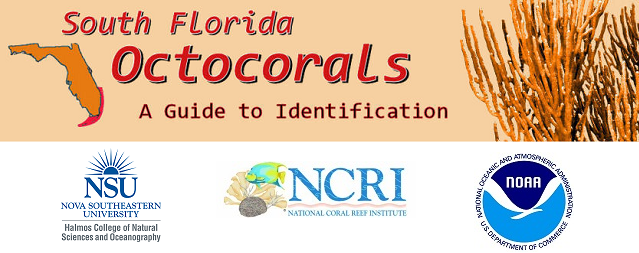Preview

Family
Plexauridae
Common Name(s)
Black sea rod
Colony Form
Bushy but in one plane.
Axis
Cylindrical
Branches
Lateral and dichotomous; thin and brittle; to 10 cm long and 2-5-5.0 mm across; crumbly when dried.
Apertures
calices inconspicuously protruding; lip present or not. Aperture round when polyps retracted. Texture smooth with slightly raised bumps.
Mucus
None
Color
Dark brown to black with light brown to yellow polyps. Dries to black or deep brown; purplish brown in alcohol.
Sclerites
Polyp armature: strong, with crown resting on distinct transverse collaret. Axial layer: deep reddish-purple capstans. Middle layer: white or rarely violet spindles to 0.8 mm long. Surface layer: large asymmetrical leaf-clubs with numerous serrate leaves, to ~0.5 mm long.
Habitat
Clear water patch reefs. Deeper-water colonies have more crowded slender branches than taller colonies in more shallow areas. Along the Outer Linear Reef ledge in Broward County, FL.
Distribution
Common in South Florida, the Bahamas and the Caribbean Sea.
Similar Species
Date Taken
4-11-2016



Notes
Secondary metabolite production includes fatty acid chain derivatives of a variety of prostaglandins, which are largely biologically inactive, and their purpose in this octocoral remains unknown. Secondary metabolites in other Euniceas may have strong anti-inflammatory, anticarcinogenic and anti-tumor activity. This species produces prostaglandin A2 (PGA) throughout most of the Caribbean at levels 1 million times higher than those of most other organisms. Molecule exhibits the same configuration at carbon 15 as mammalian prostaglandins, except in Florida where P.homomalla synthesizes large amounts of 15(R)-PGA2. Labrids have been observed grazing on the branches of this species. Oral doses of prostaglandins produce vomiting in most species, and this may act as an anti-predator chemical defense against reef fishes.